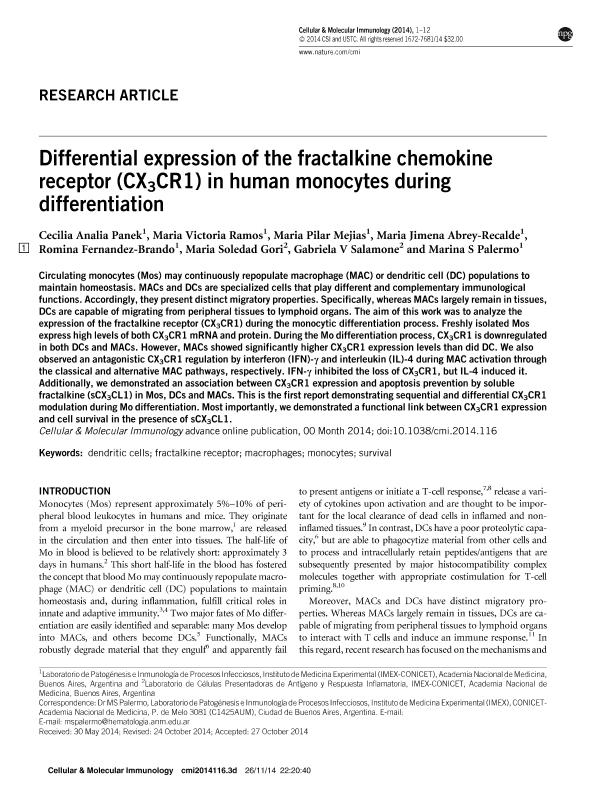Artículo
Differential expression of the fractalkine chemokine receptor (CX3CR1) in human monocytes during differentiation
Panek, Cecilia Analía ; Ramos, Maria Victoria
; Ramos, Maria Victoria ; Mejias, María Pilar
; Mejias, María Pilar ; Abrey Recalde, Maria Jimena
; Abrey Recalde, Maria Jimena ; Fernández Brando, Romina Jimena
; Fernández Brando, Romina Jimena ; Gori, María Soledad
; Gori, María Soledad ; Salamone, Gabriela Veronica
; Salamone, Gabriela Veronica ; Palermo, Marina Sandra
; Palermo, Marina Sandra
 ; Ramos, Maria Victoria
; Ramos, Maria Victoria ; Mejias, María Pilar
; Mejias, María Pilar ; Abrey Recalde, Maria Jimena
; Abrey Recalde, Maria Jimena ; Fernández Brando, Romina Jimena
; Fernández Brando, Romina Jimena ; Gori, María Soledad
; Gori, María Soledad ; Salamone, Gabriela Veronica
; Salamone, Gabriela Veronica ; Palermo, Marina Sandra
; Palermo, Marina Sandra
Fecha de publicación:
12/2014
Editorial:
Chinese Soc Immunology
Revista:
Cellular & Molecular Immunology
ISSN:
1672-7681
Idioma:
Inglés
Tipo de recurso:
Artículo publicado
Clasificación temática:
Resumen
Circulating monocytes (Mos) may continuously repopulate macrophage (MAC) or dendritic cell (DC) populations to maintain homeostasis. MACs and DCs are specialized cells that play different and complementary immunological functions. Accordingly, they present distinct migratory properties. Specifically, whereas MACs largely remain in tissues, DCs are capable of migrating from peripheral tissues to lymphoid organs. The aim of this work was to analyze the expression of the fractalkine receptor (CX3CR1) during the monocytic differentiation process. Freshly isolated Mos express high levels of both CX3CR1 mRNA and protein. During the Mo differentiation process, CX3CR1 is downregulated in both DCs and MACs. However, MACs showed significantly higher CX3CR1 expression levels than did DC. We also observed an antagonistic CX3CR1 regulation by interferon (IFN)-γ and interleukin (IL)-4 during MAC activation through the classical and alternative MAC pathways, respectively. IFN-γ inhibited the loss of CX3CR1, but IL-4 induced it. Additionally, we demonstrated an association between CX3CR1 expression and apoptosis prevention by soluble fractalkine (sCX3CL1) in Mos, DCs and MACs. This is the first report demonstrating sequential and differential CX3CR1 modulation during Mo differentiation. Most importantly, we demonstrated a functional link between CX3CR1 expression and cell survival in the presence of sCX3CL1.
Palabras clave:
Fractalkine Chemokine Receptor (Cx3cr1)
,
Monocytes
Archivos asociados
Licencia
Identificadores
Colecciones
Articulos(IMEX)
Articulos de INST.DE MEDICINA EXPERIMENTAL
Articulos de INST.DE MEDICINA EXPERIMENTAL
Citación
Panek, Cecilia Analía; Ramos, Maria Victoria; Mejias, María Pilar; Abrey Recalde, Maria Jimena; Fernández Brando, Romina Jimena; et al.; Differential expression of the fractalkine chemokine receptor (CX3CR1) in human monocytes during differentiation; Chinese Soc Immunology; Cellular & Molecular Immunology; 12; 12-2014; 669-680
Compartir
Altmétricas



